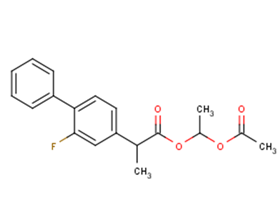
Flurbiprofen Axetil
CAS No. 91503-79-6
Flurbiprofen Axetil( Flurbiprofen Axetil | Ropion | Lipfen | LFP-83 )
Catalog No. M19255 CAS No. 91503-79-6
Flurbiprofen Axetil is an anti-inflammatory used as an analgesic.
Purity : >98% (HPLC)
 COA
COA
 Datasheet
Datasheet
 HNMR
HNMR
 HPLC
HPLC
 MSDS
MSDS
 Handing Instructions
Handing Instructions
| Size | Price / USD | Stock | Quantity |
| 5MG | 31 | In Stock |


|
| 10MG | 50 | In Stock |


|
| 25MG | 87 | In Stock |


|
| 50MG | 147 | In Stock |


|
| 100MG | 230 | In Stock |


|
| 200MG | 340 | In Stock |


|
| 500MG | 565 | In Stock |


|
| 1G | Get Quote | In Stock |


|
Biological Information
-
Product NameFlurbiprofen Axetil
-
NoteResearch use only, not for human use.
-
Brief DescriptionFlurbiprofen Axetil is an anti-inflammatory used as an analgesic.
-
DescriptionFlurbiprofen Axetil, also known as Ropion, is a prodrug of Flurbiprofen that provides better analgesia effects and few side effects.
-
In Vitro——
-
In Vivo——
-
SynonymsFlurbiprofen Axetil | Ropion | Lipfen | LFP-83
-
PathwayOthers
-
TargetOther Targets
-
RecptorCOX-1| COX-2
-
Research Area——
-
Indication——
Chemical Information
-
CAS Number91503-79-6
-
Formula Weight330.36
-
Molecular FormulaC19H19FO4
-
Purity>98% (HPLC)
-
SolubilityIn Vitro:?DMSO : 250 mg/mL (756.77 mM)
-
SMILESc1(c(cc(cc1)C(C(=O)OC(C)OC(=O)C)C)F)c1ccccc1
-
Chemical Name1-Acetyloxyethyl 2-(3-fluoro-4-phenylphenyl)propanoate
Shipping & Storage Information
-
Storage(-20℃)
-
ShippingWith Ice Pack
-
Stability≥ 2 years
Reference
1. Kathleen MK, et al. Defining the COX Inhibitor Selectivity of NSAIDs: Implications for Understanding Toxicity. Expert Rev Clin Pharmacol. 2010;3(6):769-776.
molnova catalog



related products
-
Danmelittoside
Danmelittoside is a natural product.
-
BCATc Inhibitor 2
BCATc Inhibitor 2 exhibited an IC50 of 0.8 microM in the hBCATc assays; it is an active and selective inhibitor.
-
Phosphatidylethanola...
Phosphatidylethanolamines (bovine) are a mixture of phosphatidylethanolamines isolated from bovine brain with different fatty acyl groups at the sn-1 and sn-2 positions.



 Cart
Cart
 sales@molnova.com
sales@molnova.com


